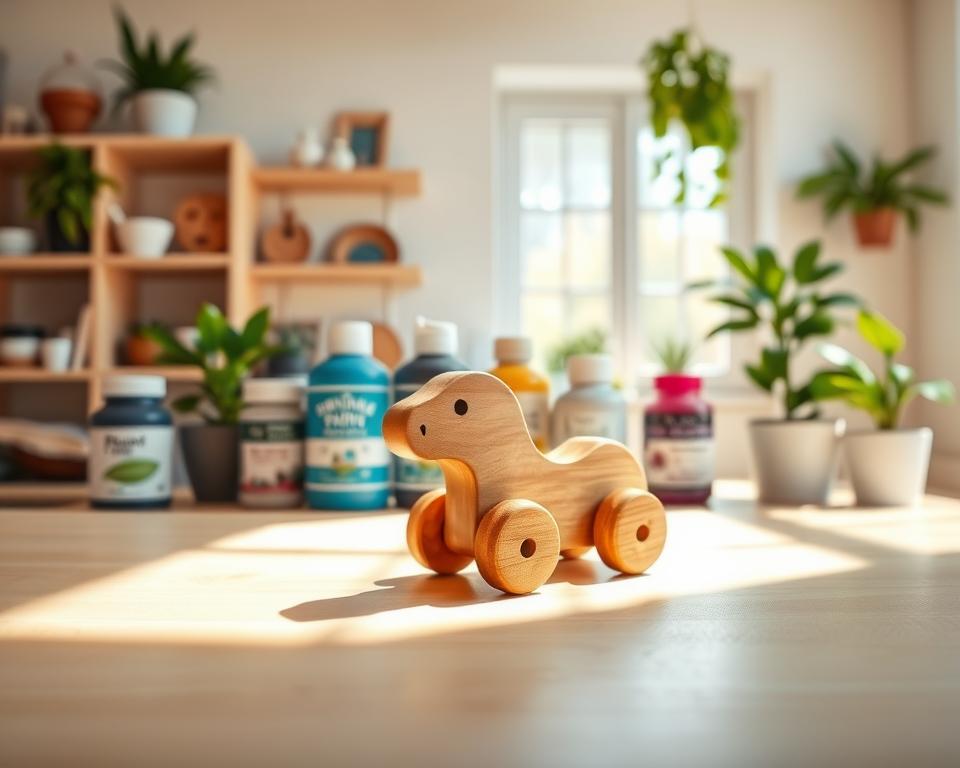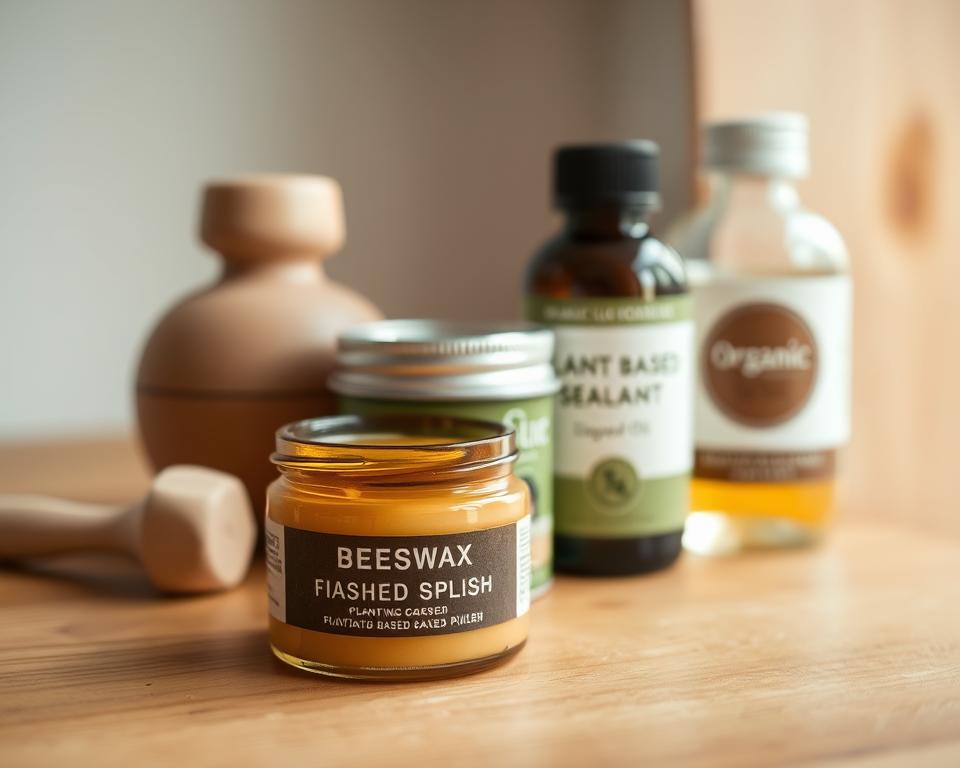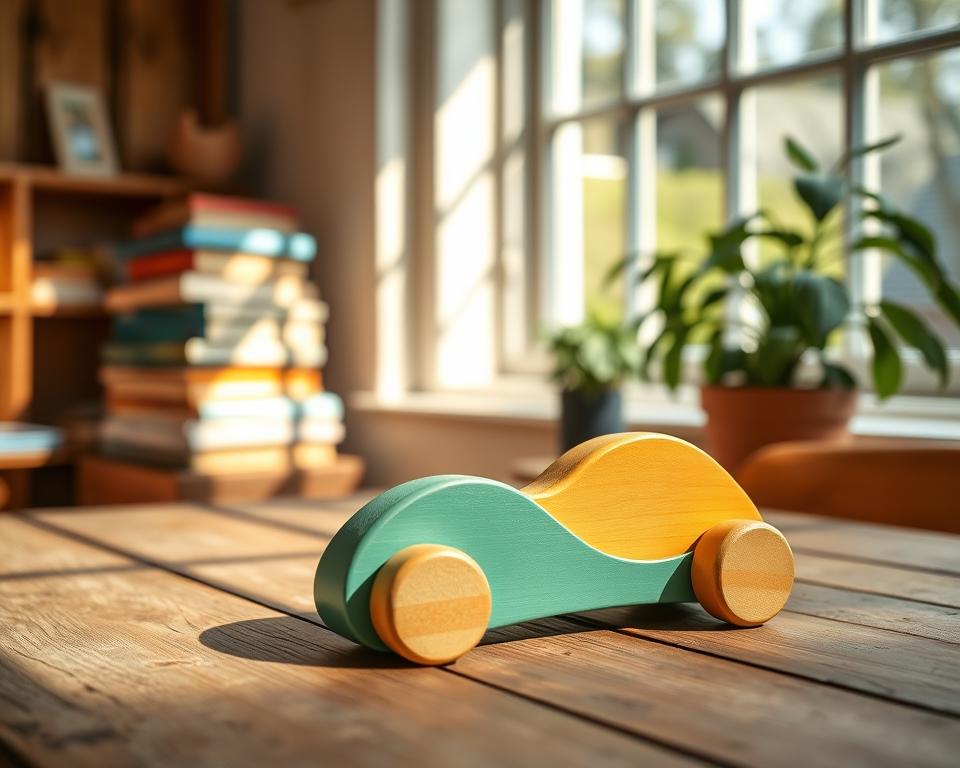Did you know that over 90% of conventional paint products contain harmful chemicals? These substances can pose risks, especially for children who often explore with their mouths. Choosing the right finish for wooden items is crucial in today’s safety-conscious world.
This guide focuses on natural, kid-friendly formulas like Real Milk Paint. Made with simple ingredients such as milk protein and lime, it’s a superior choice compared to traditional products. Not only is it non-toxic, but it’s also eco-friendly and sustainable.
We’ll explore the benefits of water-based color options, safety standards, and effective application techniques. Whether you’re crafting or refurbishing, this article will help you make informed decisions. Let’s dive into the world of natural oil and finish products that prioritize both health and the environment.
Key Takeaways
- Conventional paints often contain harmful chemicals, making natural alternatives essential.
- Real Milk Paint uses simple, non-toxic ingredients like milk protein and lime.
- Natural finishes are eco-friendly and sustainable, reducing environmental impact.
- Water-based options are safer and easier to apply on wooden surfaces.
- Understanding safety standards ensures the best choices for children’s items.
Understanding Non-Toxic Paints for Wood Toys
Parents and makers alike prioritize safety when selecting finishes for wooden creations. Non-toxic options are designed to protect children and the environment, offering peace of mind for families.
What Makes a Paint Non-Toxic?
Non-toxic finishes avoid harmful chemicals like formaldehyde and benzene. Instead, they use natural ingredients such as milk protein and earth-based pigments. These components ensure the product is safe for kids, even if it ends up in their mouths.
Real Milk Paint is a standout example. It’s free of volatile organic compounds (VOCs), which can harm health. This makes it ideal for nurseries and play areas.

Key Benefits for Kids and the Environment
Using non-toxic finishes benefits both children and the planet. These products reduce chemical exposure, promoting healthier indoor air quality. They’re also eco-friendly, often made with sustainable materials.
For instance, Real Milk Paint’s formula includes high-calcium lime, which absorbs carbon dioxide. This helps offset carbon emissions, making it a greener choice.
By choosing non-toxic options, you’re not only protecting your kids but also contributing to a healthier environment.
Safe Paint Options for Toys: How to Choose the Best Non-Toxic Finishes
Choosing the right finish for children’s items is more than just aesthetics—it’s about health. With so many products on the market, it’s essential to understand what makes a finish truly non-toxic and why certain ingredients stand out.

Ingredient Spotlight: Milk Protein, Lime, and Earth-Based Pigments
Natural ingredients like milk protein, lime, and earth-based pigments are the backbone of non-toxic finishes. Milk protein, for example, is hypoallergenic and safe for kids, even if they chew on their toys. Lime adds durability and helps absorb carbon dioxide, making it eco-friendly.
Earth-based pigments provide vibrant color without harmful chemicals. These ingredients work together to create a finish that’s both safe and long-lasting, perfect for high-traffic areas like playrooms.
Comparing Water-Based Paints to Commercial Options
Water-based finishes are a superior choice for wooden items. Unlike commercial paints, they avoid harmful compounds like VOCs, which can affect indoor air quality. Real Milk Paint, for instance, is CPSC compliant and free of toxins, ensuring it’s safe for kids.
Commercial paints often contain formaldehyde and benzene, which can pose health risks. Water-based options, on the other hand, are easy to apply and dry quickly, making them ideal for crafting or refurbishing wooden blocks and toys.
By choosing natural finishes, you’re not only protecting your family but also contributing to a healthier environment. It’s a win-win for everyone.
Steps for Applying and Sealing Wooden Toys Safely
Creating durable and child-friendly wooden items starts with proper preparation. Whether you’re crafting a new block or refurbishing an old toy, these steps ensure a smooth, long-lasting finish that’s safe for kids.
Proper Preparation and Surface Sanding
Begin by sanding the surface with fine-grit paper (120-150 grit). This removes rough spots and creates an ideal base for the paint. Wipe away dust with a damp cloth to ensure a clean surface.
Proper sanding prevents pigment shedding and ensures the color adheres evenly. This step is crucial for achieving a professional-quality result.
Application Techniques for a Smooth, Durable Finish
Mix your product according to instructions. For Real Milk Paint, use a 1:1 ratio of powder to water. Apply multiple thin coats, allowing 30 minutes of drying time between each layer.
Using a brush or sponge, work in smooth, even strokes. This technique avoids drips and ensures a consistent finish. Thin coats dry faster and reduce the risk of cracking.
Sealing Methods: Using Oils and Waxes for Extra Protection
Once the paint is dry, seal the surface for added durability. Pure Tung Oil and Half & Half Oil are excellent choices. These oil options penetrate deeply, providing a smooth, satin-like finish.
Apply the oil with a soft cloth, working it into the wood. Let it cure for 7-15 days for light use or 30 days for full durability. For extra protection, finish with a layer of Wood Wax, made from natural beeswax and carnauba wax.
Sealing prevents color bleeding and protects the surface from wear and tear. It’s especially important for items like wooden toy blocks that endure constant handling.
Conclusion
Crafting with care ensures children’s playtime remains joyful and worry-free. Choosing non-toxic finishes like Real Milk Paint protects kids and the environment. Its natural ingredients, such as milk protein and lime, offer a durable and vibrant color without harmful compounds.
Proper preparation and sealing techniques enhance the longevity of wooden toy blocks and other items. Water-based formulas are easy to apply and dry quickly, making them ideal for busy parents and makers.
By adopting these practices, you create a healthier play area and contribute to a greener planet. Start your next project with confidence, knowing your choices prioritize both safety and creativity.
FAQ
What makes a paint non-toxic for wooden toys?
Non-toxic paints are free from harmful chemicals like lead, phthalates, and VOCs. They often use natural ingredients such as milk protein, lime, and earth-based pigments, making them safe for kids and eco-friendly.
Why should I choose water-based paints for wood blocks?
Water-based paints are a great choice because they dry quickly, have low odor, and are easy to clean up. They’re also less likely to contain harmful compounds compared to some commercial options.
How do I prepare wooden toys before applying a finish?
Start by sanding the surface to remove rough spots and ensure smoothness. Wipe away dust with a damp cloth, and let the wood dry completely before adding any color or protective layer.
What’s the best way to seal wooden toys for extra durability?
Using natural oils like linseed or beeswax can seal the surface effectively. These compounds penetrate the wood, providing a protective barrier while maintaining a safe, non-toxic finish.
Are there specific ingredients I should look for in non-toxic paints?
Yes! Look for products with milk protein, lime, or earth-based pigments. These ingredients are gentle on the environment and safe for children’s toys.
Can I use commercial paints on wooden blocks?
While some commercial paints are labeled non-toxic, it’s important to check the ingredient list. Water-based or natural finishes are often a safer choice for wooden toys.
How do I ensure a smooth finish when painting wooden toys?
Apply thin, even coats using a brush or sponge. Allow each layer to dry completely before adding the next. Light sanding between coats can also help achieve a smooth result.
